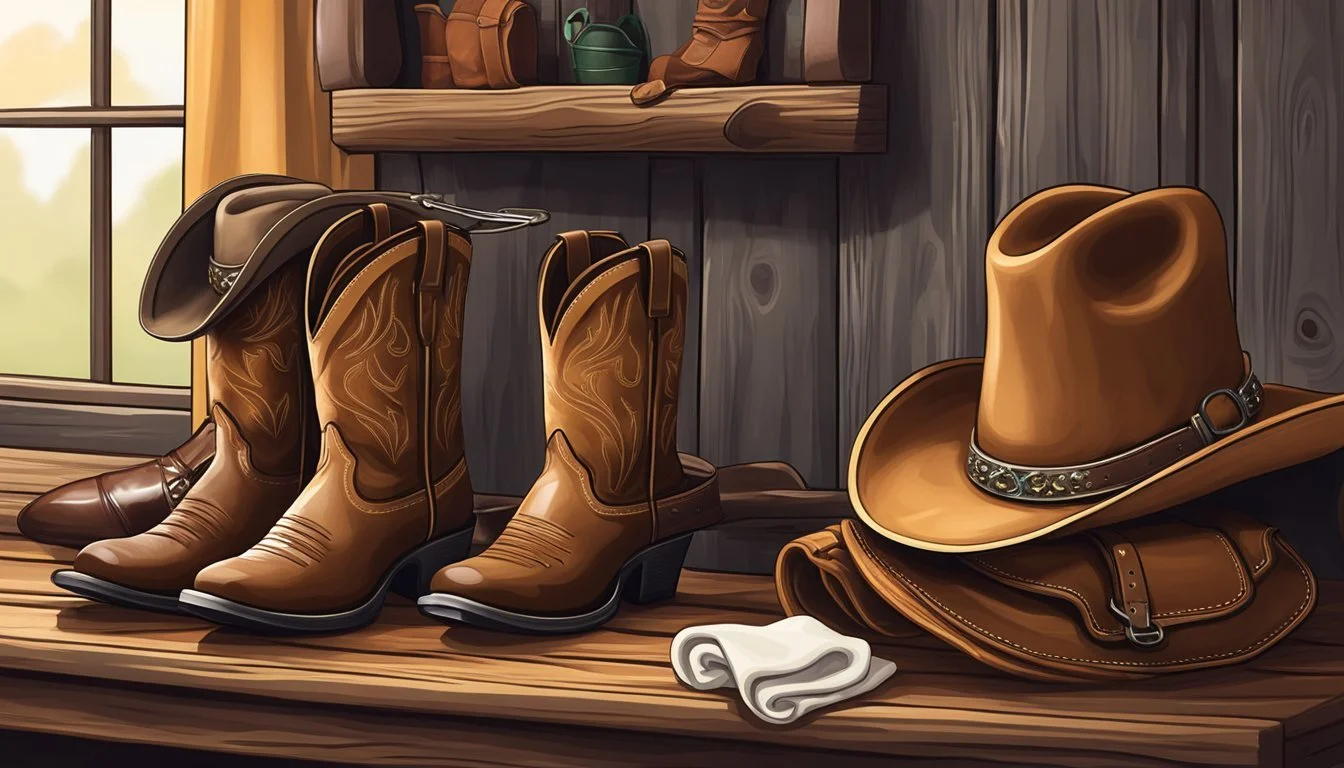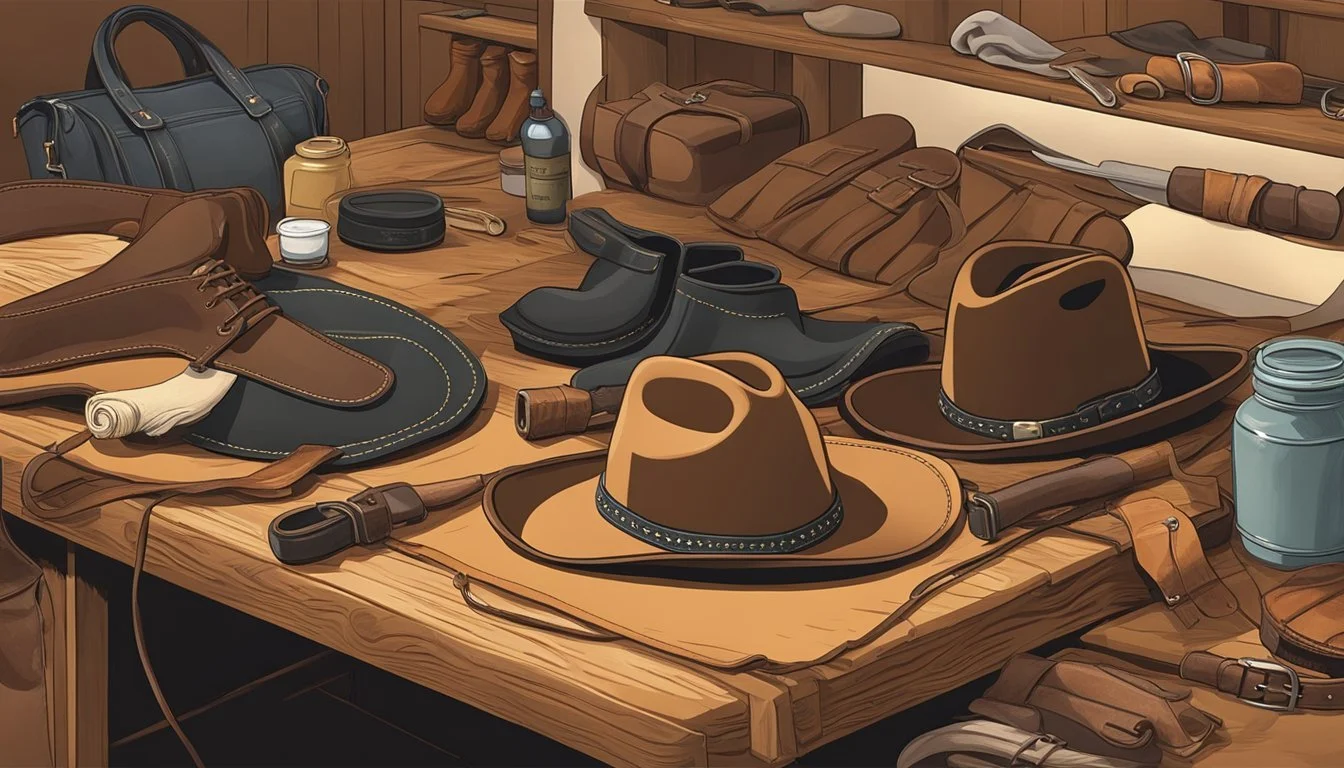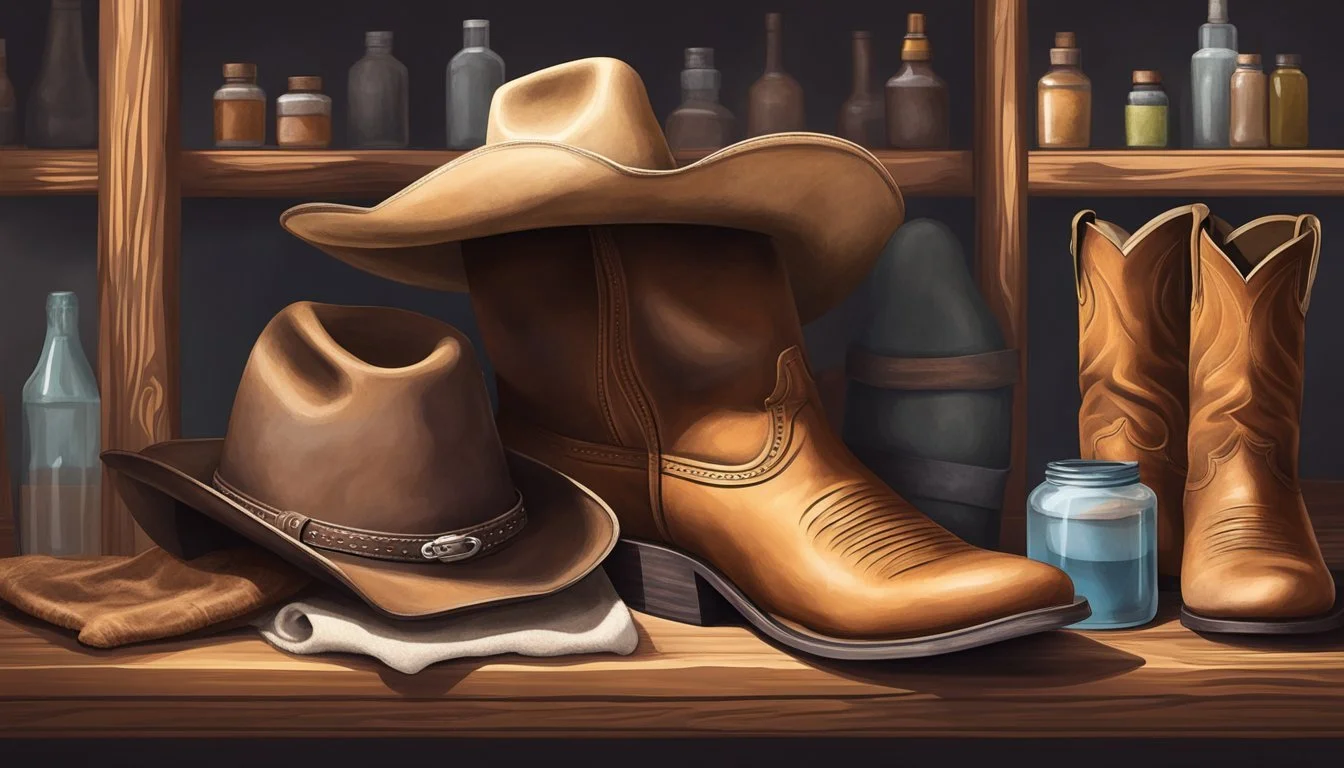How to Care for Cowboy Leather Goods
Essential Maintenance Tips
Caring for cowboy leather goods is an essential practice to ensure their longevity and performance. Leather, as a natural material, requires regular maintenance to stay supple and durable. Owners of cowboy boots and other leather accessories value their items not just for their functionality but also for the aesthetic appeal they offer. It is important to clean and condition leather consistently to protect it from the elements and to prevent it from drying out and cracking.
Among the most iconic leather items, cowboy boots stand as a testament to both tradition and personal style. Whether they're worn for ranch work, riding, or as a fashion statement, the boots need to be maintained properly. This involves cleaning the leather with a damp cloth to remove dirt and dust, applying conditioner to nourish and restore the material, and buffing the boots to bring out their natural shine. Specially formulated products are available to cater to the unique needs of leather cowboy goods, emphasizing the importance of selecting the right tools for the job.
Effective maintenance also involves protecting the leather from excessive moisture and damage. While cowboy boots are built to withstand rugged conditions, they still require careful handling to prevent premature wear. Understanding the right techniques to treat stains and the appropriate measures to keep the leather in prime condition can make all the difference. By employing the correct care regimen, enthusiasts can enjoy their cowboy leather goods for years to come, with each item developing a distinctive patina that reflects its owner's lifestyle and character.
Understanding Leather Types
When caring for cowboy leather goods, recognizing the type of leather is crucial to proper maintenance. Leather types vary greatly in texture, durability, and care requirements.
Cowhide and Exotic Materials
Cowhide is the most common leather used in cowboy boots and goods due to its durability and resilience. It's the skin of domestic cattle and is known for its toughness and versatility. Exotic leathers, on the other hand, come from non-domesticated animals. Exotic leathers include but are not limited to snakeskin, ostrich (What wine goes well with ostrich?), and alligator, each offering unique patterns and textures that require specialized care. Snakeskin, with its distinct scales, is exceptionally intricate and requires a gentle touch. Ostrich leather is prized for its unique quill patterns, while alligator leather is coveted for its luxury appearance and texture.
Differences Between Suede, Nubuck, and Full Grain Leather
Suede and nubuck are types of leather that undergo a sanding process to achieve a soft, napped finish. However, suede is made from the underside of the skin, which is softer and more porous, making it less durable yet delicate. Nubuck, on the other hand, is created from the outer side of the hide, resembling suede but is more durable and has a fine grain texture.
Full grain leather retains the complete grain layer, not sanded or buffed to remove imperfections. It is the highest quality of leather, characterized by its strength and ability to develop a patina over time. Full-grain leather is typically used in high-end cowboy goods due to its longevity and ability to withstand wear and tear while maintaining its integrity.
Cleaning Techniques
In the realm of cowboy leather goods, the integrity of the item hinges significantly on the efficacy of the cleaning techniques applied. Utilizing the correct tools and products ensures that the leather remains supple and the appearance stays pristine.
Removing Dirt and Stains
The first step in eliminating dirt and stains is to gently brush off any loose soil with a soft brush. For more ingrained dirt, a damp cloth may be used to lightly wipe the surface. It's essential to avoid excessive moisture, as it can degrade leather quality.
Materials Needed:
Soft brush
Damp cloth
Leather cleaner or saddle soap
Procedure:
Brush away loose dirt with a soft brush.
Dampen a cloth and apply leather cleaner or saddle soap to the affected area.
Blot stains gently; avoid rubbing, which may spread the dirt.
Special Care for Exotic Leather
Exotic leathers, such as snakeskin or ostrich, require careful attention. Always follow the manufacturer’s guidelines for specific cleaning techniques suited for these materials. Generally, a less-is-more approach with a light hand is the standard for cleaning exotic leathers.
Key Points:
Adhere to manufacturer instructions.
Use minimal moisture and gentle cleaners designed for exotic leather.
Daily Dusting and Maintenance
Maintenance encompasses a daily routine of dusting off your leather goods with a soft, dry cloth. This prevents buildup of grime and keeps the leather in top condition. For individuals with an active outdoor lifestyle, this simple practice is indispensable in extending the life of your leather goods.
Routine Care:
Dust daily with a soft cloth.
Address minor spots immediately to prevent staining.
In applying these targeted techniques, owners can preserve the quality and extend the lifespan of their cherished cowboy leather goods.
Conditioning and Moisturizing
Proper conditioning and moisturizing are crucial aspects for extending the life of cowboy leather goods, ensuring they remain supple and resistant to cracks.
Choosing the Right Leather Conditioner
Selection Criteria: When selecting a leather conditioner, it's essential to consider the leather type. A general rule is to use a water-based conditioner that offers hydration without damaging the leather. Ingredients such as lanolin and neatsfoot oil are often recommended, as they enhance the leather's elasticity and moisture content.
Popular Options:
Lanolin-based Conditioners: Ideal for preserving softness and suppleness.
Neatsfoot Oil Formulas: Primarily used to restore dried-out leather.
Applying Conditioner and Balm
Steps for Application:
Clean the leather thoroughly before conditioning. Dirt and debris can hinder absorption.
Test the product on a small, inconspicuous area to ensure it doesn’t alter the leather's color or texture.
Using a soft cloth, apply the conditioner in circular motions to promote even distribution.
Allow the leather to absorb the conditioner fully. This may take at least 15 minutes.
If using a leather balm, apply a small amount after the conditioner has been absorbed to add an extra layer of moisture and protection. Balm often contains waxes that provide a light sheen and additional water resistance.
Tools and Technique:
Soft, lint-free cloth or sponge for application
Buff the leather with another clean cloth after conditioning for a natural sheen
Do not over-apply as it may clog the leather's pores, leading to a residue buildup
Protecting from Damage
Proper care and maintenance significantly extend the lifespan of cowboy leather goods. By focusing on prevention, one can protect their leather items from the most common types of damage.
Avoiding Heat and Sunlight Exposure
Leather should be stored away from direct sunlight and heat sources. Prolonged exposure breaks down the fibers and can lead to fading and dryness. They should keep their cowboy leather goods in a cool, dry place to maintain their integrity.
Using Water Repellents and Waxes
Applying water repellent sprays or waxes is essential for guarding against water damage. They should choose products specifically designed for leather to ensure compatibility:
Water Repellents: Regular application can prevent water spots and swelling.
Waxes: A thin layer can act as a barrier against moisture and other elements.
Preventing Scuffs and Scratches
To shield leather from scuffs and scratches, one should handle cowboy leather goods with care:
Storage: Place boots away from sharp objects that could scratch the surface.
Careful Use: Avoid rough surfaces and activities that can damage the leather.
By adhering to these preventive techniques, they ensure the longevity and pristine appearance of their cowboy leather goods.
Proper Storage and Rest
Proper storage of cowboy leather goods is essential to maintain their shape and quality. Using the right tools and environment can significantly prolong their life and appearance.
Using Boot Trees and Support
Boot trees play a crucial role in maintaining the shape of cowboy boots. When leather boots are not in use, the insertion of boot trees helps to prevent creases and maintain the original contour. Cedar boot trees are particularly beneficial as they serve a dual purpose: they retain the shape of the boots and absorb moisture, which helps to keep the leather in optimal condition.
Ideal Types of Boot Trees:
Cedar
Plastic with a spring mechanism
Ideal Conditions for Leather Storage
The longevity of leather goods is heavily influenced by the storage environment. Leather should be stored in a cool, dry place such as a closet, where temperature and humidity levels are stable. Here are specific conditions that aid in preserving leather quality:
Temperature: Consistently cool
Humidity: Moderate (50% - 55% relative humidity)
Light Exposure: Minimal to prevent fading and drying out
Leather Storage Tips:
Wrap leather in acid-free tissue paper or store in a breathable bag to protect from dust and light.
Positioning: Boots should stand upright, possibly with the aid of a boot stand.
Avoid storage locations prone to high humidity, like bathrooms or basements.
Polishing and Finishing Touches
A polished appearance can enhance the longevity and aesthetic appeal of cowboy leather goods. Through proper polishing and employing the right techniques for a glossy finish, one can maintain the robustness and luster of their leather items.
Applying Polish for a Glossy Finish
To achieve a lasting, glossy finish, one begins by using a leather-specific cleaner to prepare the surface. This initial step ensures that any dirt or residue is removed. After cleaning, they apply a high-quality polish or boot cream designed for the leather's specific type. Using a soft cloth or horsehair brush, one works the polish into the leather with circular motions. Adequate time is allowed for the polish to absorb and dry before proceeding to the next step.
Key Steps:
Clean the leather with cleaner specific to the leather type.
Apply the recommended polish with a soft cloth or brush.
Allow to dry for optimal absorption.
Quick Tricks for an Impromptu Shine
For times when a full polish is not feasible, one can still achieve an impromptu shine. Using a dry rag or horsehair brush, a brisk rub over the surface can enhance the leather's natural sheen. While less thorough than a complete polish, this quick method is effective for immediate visual improvement and can help in extending the intervals between full polishing sessions.
Quick Shine Steps:
Briskly rub the leather with a dry, clean rag or horsehair brush.
Repeat as necessary to attain a simple, enhanced sheen.
Following these practices, owners of cowboy leather goods can ensure their items remain pristine and well-maintained, displaying a refined and glossy finish.
Advanced Care and Rejuvenation
Proper rehabilitation of leather cowboy goods requires targeted treatments to address specific issues like cracking and dryness, ensuring the longevity and aesthetic appeal of the items.
Dealing with Cracking and Creases
When one encounters cracking or crevices in their leather goods, the first step is to clean the leather thoroughly to remove any dirt or grime. It is best to use a soft brush or dry cloth to lift mud or debris gently from the cracks. For deeper crevices, a specially formulated leather cleaner should be utilized. After cleaning, the leather must be allowed to air dry completely, away from direct heat sources.
To address the cracks, a quality leather conditioner should be applied. The conditioner aids in restoring suppleness and can be rubbed into the leather using small circular motions, allowing it to penetrate effectively. Post application, the item should be left to sit for approximately 15 minutes before buffing off any excess product, revitalizing the leather's appearance and reducing the visibility of cracks and creases.
Revitalizing Dry and Aged Leather
Leather that has lost its natural oils and moisture requires a delicate rejuvenation process to bring back its former elasticity and prevent further degradation. A hydrating leather conditioner should be selected for this task—one that does not contain harmful chemicals and is appropriate for the specific type of leather.
A multi-step approach is beneficial for dry and aged leather:
Clean: Remove surface-level contaminants with a damp cloth.
Condition: Apply a generous amount of conditioner to rehydrate the leather.
Absorb: Allow the leather to absorb the conditioner; a wait time of 30 minutes can ensure deeper penetration.
Buff: After the conditioner has been absorbed, buff the leather with a clean, soft cloth to restore shine and promote even distribution of the conditioner.
It's also advisable to periodically apply a waterproofing treatment to the leather, which helps it maintain its ability to repel water and breathe. This preemptive care is essential, as it helps to prevent leather from becoming excessively dry and aged in the future. Waterproofing treatments should be applied in light layers according to the manufacturer's instructions and the leather should be left to dry naturally.
Special Considerations for Cowboy Boots
When caring for cowboy boots, one must account for their unique features such as intricate decorative details and specialized insoles. These aspects require specific attention to maintain their condition and extend their lifespan.
Decorative Stitching and Embroidery Care
Decorative elements on cowboy boots, like stitching and embroidery, need gentle cleaning to preserve their appearance. To clean these delicate areas, one should:
Avoid harsh scrubbing to prevent thread damage.
Use a soft-bristled brush to delicately remove dust and dirt.
Gently apply a suitable leather cleaner with a soft cloth, if necessary.
For boots showcasing colored threads, it’s crucial to test the cleaner on an inconspicuous area to ensure it does not cause fading or bleeding.
Fitting and Insole Maintenance
Proper fitting and insole maintenance are vital for enduring comfort and boot longevity. Observing the right practices can make a significant difference:
Ensure that boots fit snugly but comfortably, allowing a little give for the insole to form to the foot.
Remove insoles periodically to air them out, preventing moisture accumulation.
To clean the insole:
Remove the insole if it is not glued in.
Use a mild cleanser to wipe down the surface.
Air-dry completely before reinserting to fend off mildew and odors.
Frequent checks for wear and tear can help catch issues early, maintaining the integrity of the cowboy boots' interior for continuous support and comfort.





